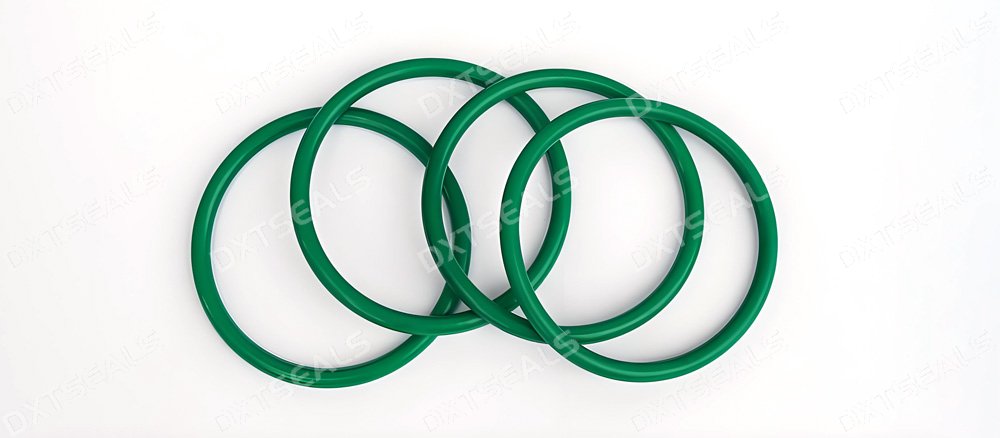Introduction
Rubber O-rings are one of the most widely used sealing solutions in various industries, thanks to their simplicity, effectiveness, and adaptability. These small, doughnut-shaped seals play a crucial role in preventing fluid or gas leaks between mating surfaces. While rubber O-rings are common in everyday applications, their performance in harsh environmental conditions is what makes them indispensable in high-pressure, high-temperature, and chemically aggressive environments.
This article will explore the role of rubber O-rings in sealing applications under extreme conditions, including their material properties, advantages, and key applications.
1. What Are Rubber O-Rings?
A rubber O-ring is a circular sealing component made from elastomeric materials that is designed to fit into a groove to prevent the passage of fluids or gases. The basic design of the O-ring helps it create a tight seal by applying pressure around the groove. Rubber O-rings are used to seal dynamic or static applications in machinery, engines, pipelines, and many other systems.
2. Key Materials for Rubber O-Rings in Harsh Environments
The performance of a rubber O-ring depends largely on the material used. Different elastomers offer varying levels of resistance to extreme temperatures, pressures, and chemicals. Some of the most common materials for harsh environmental applications include:
- Nitrile (NBR): Offers excellent resistance to oils, fuels, and hydraulic fluids. Ideal for applications where oil and fuel exposure is common.
- Fluorocarbon (FKM): Known for its resistance to high temperatures and chemical environments, FKM is widely used in aerospace, automotive, and chemical processing industries.
- Ethylene Propylene Diene Monomer (EPDM): Excellent for sealing in high-temperature and chemical environments, especially where water, steam, and alkaline conditions are present.
- Silicone (VMQ): Ideal for extreme temperatures, especially in low-temperature environments, with high flexibility at low temperatures and resistance to oxidation.
- Chloroprene (CR): Resistant to weathering, ozone, and aging, making it suitable for outdoor applications.
Each of these materials can be tailored to meet the specific needs of a particular application, enhancing the O-ring’s performance in extreme conditions.
3. The Role of Rubber O-Rings in Harsh Environmental Conditions
Rubber O-rings play a crucial role in sealing systems exposed to challenging environments. Whether in high-pressure, high-temperature, or corrosive conditions, these seals ensure that equipment operates efficiently and safely by preventing leaks. Here's how rubber O-rings perform in harsh conditions:
a) High-Temperature Performance
Rubber O-rings can be formulated with materials that allow them to withstand high-temperature conditions, typically between -60°F to +450°F. For extreme high-temperature applications, materials like FKM and silicone provide excellent sealing performance by retaining their flexibility and shape even under heat stress.
b) Chemical Resistance
Rubber O-rings are essential in applications where sealing is required in environments with harsh chemicals, acids, and solvents. O-rings made from FKM, EPDM, and NBR are particularly known for their chemical resistance, making them ideal for use in the chemical, petrochemical, and pharmaceutical industries.
c) High-Pressure Sealing
In industrial systems, rubber O-rings are often exposed to high-pressure environments, such as hydraulic systems and compressors. Materials like NBR and FKM provide effective sealing, ensuring that no leaks occur despite the increased pressure. These seals maintain their resilience and elasticity even under pressure, ensuring a consistent and reliable seal.
d) Extreme Cold Environments
In cold environments, such as those encountered in aircraft, cryogenic systems, and refrigeration units, rubber O-rings made from silicone or EPDM retain their sealing properties while remaining flexible and capable of handling extreme cold temperatures as low as -100°F.
4. Advantages of Rubber O-Rings for Harsh Environments
Rubber O-rings offer numerous benefits for sealing in harsh environments. Below are some of the key advantages that make them the go-to solution for various industries:
- Versatility: Rubber O-rings are available in a wide variety of materials, allowing engineers to select the right type for specific applications.
- Cost-Effective: Compared to more complex sealing solutions, rubber O-rings are affordable while still providing excellent performance.
- Ease of Installation: O-rings are simple to install and can be applied in numerous applications with minimal effort.
- Reusability: In some cases, rubber O-rings can be reused after cleaning and inspection, making them a sustainable option.
- Leak Prevention: Rubber O-rings form a tight seal that prevents gas, liquid, or vapor leaks, which is essential in high-pressure or high-temperature systems.
5. Applications of Rubber O-Rings in Harsh Environments
Rubber O-rings are used across a variety of industries where extreme environmental conditions are present. Some of the key applications include:
- Automotive: In engines, fuel systems, and air conditioning units, rubber O-rings are used to prevent leaks in high-pressure and high-temperature systems.
- Aerospace: O-rings are used in aircraft engines, fuel systems, and hydraulic systems, where they are exposed to extreme temperatures and pressure variations.
- Oil & Gas: In drilling equipment, pipelines, and subsea systems, rubber O-rings provide reliable sealing in harsh offshore conditions.
- Chemical Processing: Rubber O-rings are used in pumps, valves, and reactors where chemicals are handled, offering resistance to corrosive substances and high temperatures.
- Pharmaceutical and Food Industries: In these industries, rubber O-rings must meet strict hygiene standards while also offering resistance to chemicals and temperature extremes.
6. Conclusion
Rubber O-rings are versatile, cost-effective, and reliable sealing solutions for applications in harsh environments. With the ability to withstand high pressures, extreme temperatures, and exposure to aggressive chemicals, rubber O-rings are indispensable in industries ranging from automotive to aerospace, and from oil and gas to food processing. By selecting the right O-ring material for the specific environment, manufacturers can ensure leak-free, safe, and efficient operations.

